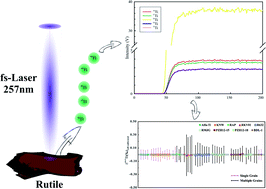In situ Ti isotopic analysis by femtosecond laser ablation MC-ICP-MS†
Abstract
Titanium (Ti) isotopes are emerging as a power tool for studying magmatic processes on the Earth and other planets. Pioneering studies carried out bulk-rock Ti isotopic measurements by conventional solution nebulization multi-collector inductively coupled plasma mass spectrometry (SN-MC-ICP-MS) and in situ Ti isotopic analysis via secondary ionization mass spectrometry (SIMS), which sacrificed spatial resolution and had relatively low analytical precision, respectively. In this work, a novel and robust method for in situ Ti isotopic analysis of titanium-bearing minerals (i.e., rutile and ilmenite) was presented, based on a femtosecond laser ablation multi-collector inductively coupled plasma mass spectrometer (fs-LA-MC-ICP-MS). Very stable isotopic signals can be ensured after careful optimization of the parameters of fs-LA (e.g., fluence, spot size, and frequency), and thus a high analytical precision has been obtained for Alfa-Ti (an ultrapure Ti metal rod) under a high spatial resolution of spot diameter = 30 μm. The within run and external reproducibility for δ49/47Ti (49Ti/47Ti isotopic ratio, reported as δ49/47Ti notation, in parts in 103) measurement on Alfa-Ti are 0.05‰ (2SE, internal precision of within-spot analysis) and 0.07‰ (2SD, external reproducibility of spot-to-spot analysis), respectively. A series of titanium-bearing minerals, including five potential rutile U–Pb chronological standards and four potential ilmenite Fe isotope standards, were assessed for Ti isotopic homogeneity on a 30 μm-scale and precision of the measurement. The most homogeneous minerals were subsequently used to comprehensively evaluate the analytical accuracy and potential matrix effect. Our results show that in situ Ti isotopic analysis is susceptible to matrix effects when using fs-LA and accurate δ49/47TiOL-Ti values (calibrated against the OL-Ti reference material developed in the Origins Laboratory of the University of Chicago) can be obtained when a matrix-matched reference material is used as a bracketing standard. Therefore, well characterized matrix-matched reference materials are necessary for in situ Ti isotopic analysis. KNW rutile and PZH12-15 ilmenite characterized in this study show potential as suitable reference materials for micro-beam Ti isotopic analysis.



 Please wait while we load your content...
Please wait while we load your content...